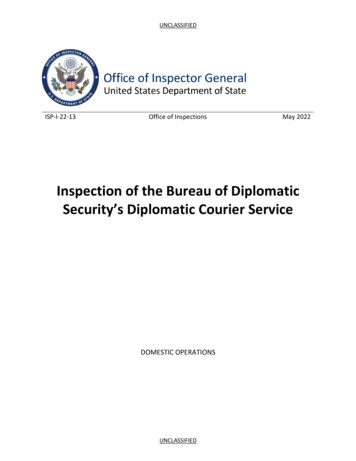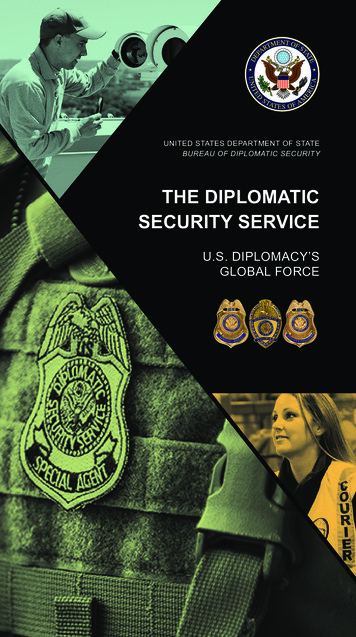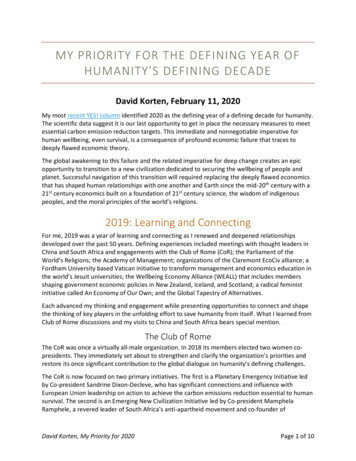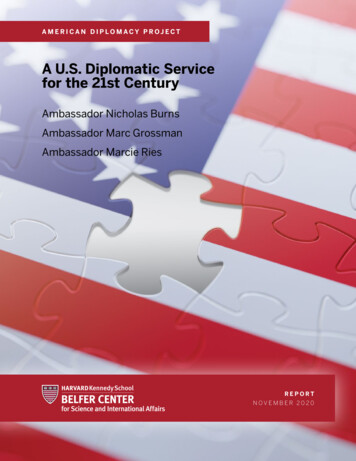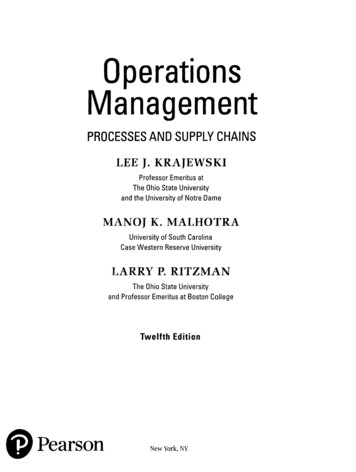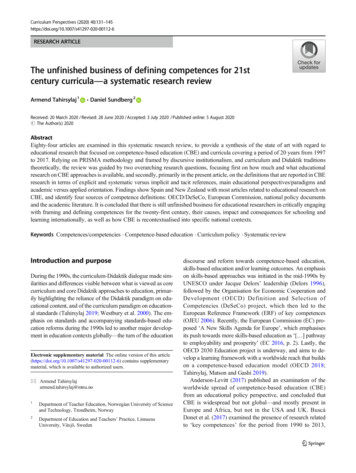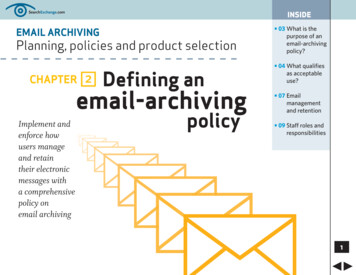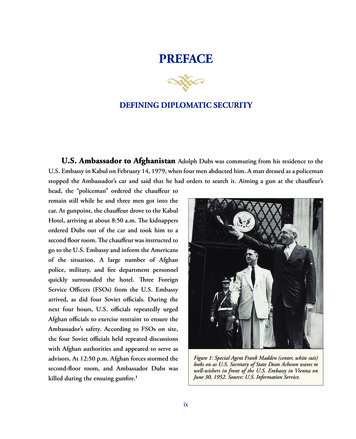
Transcription
PREFACE DEFINING DIPLOMATIC SECURITYPREFACE8DEFINING DIPLOMATIC SECURITYU.S. Ambassador to Afghanistan Adolph Dubs was commuting from his residence to theU.S. Embassy in Kabul on February 14, 1979, when four men abducted him. A man dressed as a policemanstopped the Ambassador’s car and said that he had orders to search it. Aiming a gun at the chauffeur’shead, the “policeman” ordered the chauffeur toremain still while he and three men got into thecar. At gunpoint, the chauffeur drove to the KabulHotel, arriving at about 8:50 a.m. The kidnappersordered Dubs out of the car and took him to asecond floor room. The chauffeur was instructed togo to the U.S. Embassy and inform the Americansof the situation. A large number of Afghanpolice, military, and fire department personnelquickly surrounded the hotel. Three ForeignService Officers (FSOs) from the U.S. Embassyarrived, as did four Soviet officials. During thenext four hours, U.S. officials repeatedly urgedAfghan officials to exercise restraint to ensure theAmbassador’s safety. According to FSOs on site,the four Soviet officials held repeated discussionswith Afghan authorities and appeared to serve asFigure 1: Special Agent Frank Madden (center, white suit)looks on as U.S. Secretary of State Dean Acheson waves towell-wishers in front of the U.S. Embassy in Vienna onJune 30, 1952. Source: U.S. Information Service.advisors. At 12:50 p.m. Afghan forces stormed thesecond-floor room, and Ambassador Dubs waskilled during the ensuing gunfire.1ix
History of the Bureau of Diplomatic Security of the United States Department of StateThe abduction and death of Ambassador Dubshighlighted the importance of diplomatic securityand prompted U.S. Department of State officialsto reexamine the security measures that they hadin place. The United States has always had someform of diplomatic security, yet the threats to U.S.diplomacy and the measures that the Department ofState has employed to counter them have changedconsiderably over time. This history explores howdiplomatic security at the Department of State hasFigure 2: A security detail of DS Special Agents, positionedleft and right immediately behind U.S. Secretary of StateHillary Rodham Clinton, provides protection during her2009 mission to Indonesia. Source: Associated Press.evolved from the American Revolution to the postCold War era.Broadly defined, diplomatic security is the setof measures enacted to ensure that the diplomaticrepresentatives of a nation-state, kingdom, or otherpolitical entity are able to conduct that entity’sforeign affairs in a confidential, safe manner. Securityis a basic function of diplomacy, and specificcomponents of diplomatic security include preservingthe confidentiality of diplomatic documents andcommunications, protecting diplomatic personnel,ensuring the integrity of diplomatic personnelthrough background investigations, and safeguardingdiplomatic posts overseas and diplomatic facilities athome.Figure 3: During a training session, two DS Special Agentsfrom a Mobile Security Deployments team demonstrate toU.S. embassy staff how to counteract an aggressive wristgrab. Source: Private collection.This history focuses on how the Bureau ofDiplomatic Security (DS) and each of its predecessors(the Office of Security, the Security Office, and theOffice of the Chief Special Agent) emerged andchanged over the course of nearly a century. The work also describes how and why several security-relatedfunctions became centralized into a security office. Until recently, the personnel and resources devoted to theDepartment’s security office have been small in relation to the enormous task confronting the Department’ssecurity professionals. As a result, individuals figure prominently in this history and their contributions arehighlighted when possible.x
PREFACE DEFINING DIPLOMATIC SECURITYPractices, procedures, and responsibilities oftenarise well before a bureaucracy designates a personor office to specialize in that task. Historians ofcryptology have shown that rulers and diplomatsused codes and ciphers in communications longbefore a national, city-state, or royal governmentdevoted an entity or person exclusively to thecreation of codes or the encryption / decryption ofcommunications. Past generations of U.S. diplomats,including the first diplomat Benjamin Franklin,gave serious consideration to diplomatic security,yet, how they conceived the threats they faced andthe countermeasures they devised were determinedby the available technology and the milieu in whichthey lived. Some measures have changed so markedlythat they now seem minimally related to security, yetthe contribution of such “forgotten” measures to theFigure 4: Diplomatic Courier Philip F. Vandivier boardsan airplane with two diplomatic pouches at the FrankfurtRegional Courier Facility in 1951. Source: Bureau ofDiplomatic Security Files.history of diplomatic security is unmistakable. Forexample, from 1800 to 1916, Despatch Agents werethe Department’s foremost security personnel, buttheir work has changed significantly so that they areno longer viewed as security personnel.Rather than trying to discuss each of the manysecurity-related measures enacted by the Departmentof State, this history concentrates upon the broadercontext of threats and crises confronting theDepartment during a particular era, as well as themeasures that fell eventually under the purview of DS.The work examines such measures as codes, couriers,espionage countermeasures, physical security, andFigure 5: An array of fraudulent documents seized asevidence in DS operations. In 2008, DS conductedthousands of investigations into passport and visa fraudculminating in 2,448 arrests. Passport and visa fraud isoften committed in connection with other crimes such asinternational terrorism, narcotics trafficking, and aliensmuggling. Source: Department of State.protective details. Other measures are discussed whenthey are relevant for a particular era. Investigationof passport and visa fraud, for example, was criticalduring World War I, World War II, and the 1990s,xi
History of the Bureau of Diplomatic Security of the United States Department of Statebut is discussed little beyond those junctures despiteremaining a key responsibility for DS and itspredecessors throughout the twentieth century.The chapters are organized chronologically andby what might be described as “security frameworks.”Each chapter details how a unique set of diplomaticthreats upset the existing security framework and howDepartment officials devised new countermeasuresto respond to the new threats, often building uponexisting measures or innovating new ones. The riseFigure 6: A DS Computer Investigations and Forensicsbranch chief (center) observes as two DS Special Agentsprepare equipment to make forensic images of digitalevidence. Such evidence is used for visa and passport fraudcases, other criminal cases, and counter-intelligence. Source:Department of State.of a new framework frequently resulted from aspecific event. In chapters 1, 2, 3, 4, 5, and 7, theevents respectively are World War I, World War II,the Amerasia affair, McCarthyism, public disclosureof a “bug” network in the U.S. Embassy in Moscow,and the 1983 suicide bomber attack on the U.S.Embassy in Beirut, Lebanon. In other chapters, thenew frameworks resulted from broader national orinternational developments. For chapters 6, 8, and 9,the developments respectively are the rise of terrorism,the creation of the Bureau of Diplomatic Security,and the resurgence of terrorism as the predominantthreat to U.S. diplomacy. Also discussed in Chapters7, 8, and 9, the computer revolution of the latetwentieth century fostered new threats and new facetsFigure 7: DS Mobile Security Deployments (MSD) agents(foreground) coordinate with a DS protective security detail(rear) for the visit of the U.S. Secretary of State at anoverseas location. Source: Bureau of Diplomatic SecurityFiles.of diplomatic security. The conclusion offers severalobservations about the nature of diplomatic securityand, along with the epilogue, examines diplomaticsecurity since the terrorist attacks of September 11,2001 on the World Trade Center.Finally, the history of diplomatic security offers a unique window into U.S. diplomacy and the Departmentof State. Often overlooked by many histories of U.S. diplomacy, the functional operations and organizationalstructure of the Department have profoundly affected the conduct of U.S. diplomacy. For example, an agingcommunications network hampered U.S. diplomacy during the Cuban Missile Crisis in 1962. This history alsoxii
PREFACE DEFINING DIPLOMATIC SECURITYoffers new insights to familiar episodes. For example,contrary to popular understanding, U.S. SenatorJoseph McCarthy did not fabricate his figures aboutthe number of Communists in the Department ofState. McCarthy derived his numbers from materialspresented to Congress by the Office of Security (SY);however, McCarthy repackaged the information insuch a way that it took SY officials weeks to determinethe source.z Acknowledgments åFigure 8: A DS weapons-of-mass-destruction specialist(front left, bending over) trains foreign law enforcementofficials at the International Law Enforcement Academy inGaborone, Botswana. Source: ILEA Gaborone.The Office of the Historian thanks the nearly 30retired and current Special Agents, Security Engineers,and specialists from the Bureaus of DiplomaticSecurity and Information Resource Managementwho generously gave their time for oral historyinterviews. Without them, this book would not havebeen possible. They are: Jim Bacigalupo, John Bagnal,Mike Beckner, Peter Bergin, Al Bigler, Robert Booth,Greg Bujac, Fred Burton, Michael Considine, AndyCorsun, “Courier X,” Bill DeCourcey, Bill D’Urso,David Fields, Richard Gannon, Steve Gleason,Gordon Harvey, George Herrmann, Al Herto, SteveJacobs, John Kaufman, Bruce Matthews, ScottMcGwire, Patti Morton, David McCabe, MichaelParks, Casper Pelczynski, Dennis Pluchinsky, JohnRendeiro, Paul Sorenson, Robert Surprise, CharlieWisecarver, and John Wolf.The Office of the Historian has accrued manyother debts during the process of researching andwriting this history and expresses its gratitude toFigure 9: Special Agents Joseph Rosetti and JamesMcDermott (center rear and right) provide protection forKing Hussein of Jordan (center, light suit) during his 1959visit to the United States. Source: Aviation News Pictures.those individuals. Assistant Secretary of State forDiplomatic Security Francis X. Taylor merits specialthanks because he proposed and commissionedxiii
History of the Bureau of Diplomatic Security of the United States Department of Statethis history. The Office of the Historian thanks thestaffs of the Ralph J. Bunche Library, the Office ofInformation Programs and Services, the NationalArchives, and the Library of Congress for theirassistance in locating relevant materials. In the Officeof the Historian, Amy Garrett, Mark Hove, andJennifer O’Neal conducted the initial research andwrote the first drafts on topics that appear in thechapters. Mark Hove is the author of this book, otherthan the Epilogue. He conducted a second round ofresearch, organized and wrote the chapters, completedmultiple revisions and supplemental research, andselected the illustrations. Eric Boswell, Greg Bujac,Jeffrey Culver, Robert Downen, David Nickles,Figures 10 and 11: One of the many listening devicesplanted in U.S. diplomatic facilities in Communist bloccities to conduct espionage against American diplomats.Technical Security Engineers discovered the device in theresidence of the Counselor of the U.S. Embassy in Prague,Czechoslovakia, in 1954. The lower image is the detail ofthe device located within the grey rectangular box to the left,in the above figure. Source: Bureau of Diplomatic SecurityFiles.Greg Starr, and Susan Tully read the entire work andoffered many valuable comments and suggestions.Others who contributed in ways large and smallinclude Bill Armor, Jim Bacigalupo, Paul Claussen,Evan Duncan, George Herrmann, Doug Kraft, andChris Tudda. Grace Moe and Robert Downen of theDS Public Affairs Office merit special thanks for theirinvaluable help in writing the 2001-2010 Epilogue,as well as in editing the entire text, locating additionalillustrations, and bringing this work to final bookform.EndnotesU.S. Department of State, Office of Security, TheKidnapping and Death of Ambassador Adolph Dubs, February14, 1979, Kabul, Afghanistan (Washington DC: Departmentof State, 1980).1Figure 12: A controlled explosion of a vehicle duringa DS training exercise. Source: Bureau of DiplomaticSecurity Files.xiv
Technical Security Engineers discovered the device in the residence of the Counselor of the U.S. Embassy in Prague, Czechoslovakia, in 1954. The lower image is the detail of the device located within the grey rectangular box to the left, in the above figure. Source: Bureau of Diplomatic Security Files.
